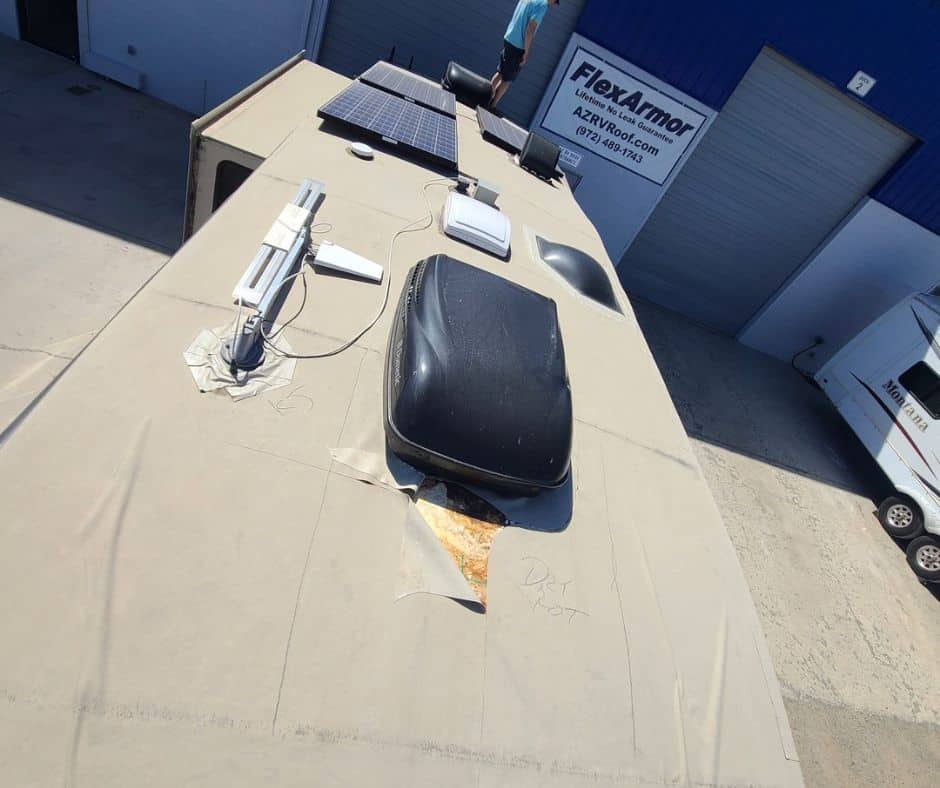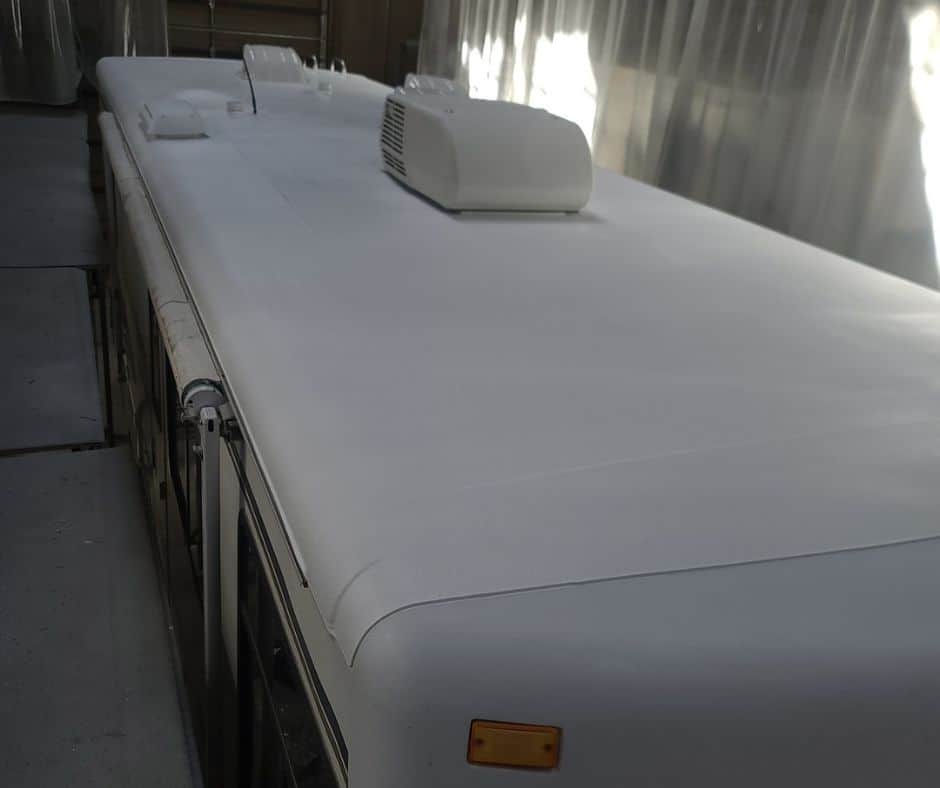I know how tempting it is to walk on your RV’s roof when you want to work on it, add something like a solar panel, or clean off tree debris after a big storm.
After all, you all see people sitting and walking on the roof of their RV in the infield at a NASCAR race.
You might wonder if it’s safe to walk on my RV’s roof?
The smart money says that you should never assume that walking on your RV’s roof is safe. Most RVs aren’t built with trusses and stringers that residential roofs rely on for their robust structure.
While many RV roofs can hold the weight of some solar panels or a satellite dish, but still don’t have the structural support to hold a full-grown adult.
Still, what happens if you need to walk on your RV’s roof to fix a roof leak, power wash it, or install some solar panels? You might need to get onto your RV’s roof for many good reasons.
Yet before you prop up a ladder and tromp around, it helps to know more about RV roofs, how they’re supported, and how you might reduce the odds of having a problem once you’re up there.
Reasons Why You Might Need To Walk On Your RVs Roof
There are many seemingly good reasons why you might be tempted to climb up and walk on your RV’s roof. This includes things like:
I understand how frustrating it can be to find yourself in the middle of one of these jobs.
You’re forced to perch yourself at the top of a tall ladder with a questionable weight rating.
You’re stretching out as far as your arms can reach, the beaming sun is beating on your arms, and the simple act of leaning an extra six inches to get that last stick or put in that last screw makes the legs of the ladder tremble like a newborn colt.
In a moment like that, it probably feels like it would be easier to crawl up on the RV’s roof to finish what you’re doing.
Even if that little voice in the back of your head is telling you, that the smart thing to do is to go back down, move the ladder over, and climb back up.
Is It Safe to Walk on My RV’s Roof?

Even if there’s a ladder on the back of your RV, you should never consider it 100% safe to walk on your RV’s roof. Most have only 3/8-inch-thick plywood under a very thin rubber membrane.
If you need to walk on your RV’s roof, you should try to stick to the edges and the stringers while also trying to distribute your weight.
Even if you have a strong fiberglass roof on your RV, you should still be trepidatious about walking on your RV’s roof.
Especially if it’s raining or wet in any way. Fiberglass RV roofs can get very slippery in the rain.
So no matter what the conditions, you should make an effort to distribute your weight and secure yourself from falling off or falling through.
How Much Weight Can an RV Roof Support?
The general rule of thumb is that most RVs can support up to 250-pounds. Though this is a distributed 250 pounds.
As in 250-pounds of snow and ice or wide solar panels. Not a 249-pound grown man is standing on thin aluminum RV roof panels with a pair of hiking boots.
How Do You Know If You Can Walk on Your RV’s Roof?
There are a few things you need to consider knowing if it’s reasonably safe to walk on your RV’s roof.
This includes things like the type of roof material, as well as the construction engineering, and where the weak spots are.
How To Assess The Weight Capacity Of An RV Roof

A few things can increase or decrease the real-world weight capacity of your RV’s roof. This includes:
It’s also worth noting that some RV roofs have strong and weak spots.
Tips For Identifying The Strongest Areas To Step On An RV’s Roof
Some parts of an RV roof are stronger than others. Let’s say you’re in a tough spot, the wind is blowing, and you need to get that flexible solar panel mounted tonight.
If you’re going to risk it, there are some stronger parts of an RV’s roof to stick to. This includes:
How To Identify The Weakest Parts Of An RV’s Roof
If you take the risk of walking on your RV’s roof, there are some areas to avoid. These weak spots include:
Different RV Roof Materials & How They Affect Weight Capacity
Different RV materials are stronger than others. Some also lend toward different engineering techniques that further make the roof a little stronger for walking on.
1. RV Roofs With a Rubber Membrane
There are two different types of rubber membranes that you might find on an RV roof. They are EPDM (Ethylene Propylene Diene Monomer), or a TPO (Thermal Poly Olefin).
While TPO tends to be more puncture resistant, both have relatively the same modest weight capacity.
Most of these RV roofs are supported by a series of metal cross braces that support a very 3/8″ to half-inch plywood sheeting. Then the thin EPDM or TPO roof membrane is applied to provide waterproofing.
This is one of the more common types of RV roofing strategies. However, this minimal approach to structural integrity makes it a bad idea to ever walk on an RV roof with a rubber membrane.
One misstep could cause the thin underlying plywood to give way, making a massive hold the size of your foot or your whole leg.
2. Fiberglass RV Roofs
You can usually spot a fiberglass RV roof by its shiny, hard surface that often has round corners and counters. This is the next step up in structural integrity from rubber membrane RV roofing.
The thick fiberglass material tends to provide a stronger surface that is hard enough to not bend or flex. Though you still shouldn’t push your luck. It’s best to keep the weight on the fiberglass to 250-pounds or less.
Fiberglass RV roofs also tend to be slippery. Especially if they get wet. So, you should try to never go up on one even if it’s lightly raining. If you need to walk on your roof to pressure wash it or to reapply a new layer of sealant, you should take safety measures to prevent a fall.
3. Aluminum RV Roofs

Aluminum roofing has fallen out of favor in RV construction in recent years. So, you’ll likely only find it in older RVs. Aluminum RV roofing on its own doesn’t offer a lot of structural integrity.
Though some RV manufacturers like Airstream that still use aluminum exteriors do have models with the same level of reinforcement as you would find on an RV with a rubber membrane and plywood.
Otherwise, if you have an older RV with an aluminum roof, the weight of a human being on a roof is likely to cause the panels to deform and could separate the seals leading to major roof leaks.
RV Manufacturers With The Strongest Roofs?
Regarding the best RV manufacturers with strong roofs, you can further break the options between fiberglass models and models with a rubber membrane covering plywood.
The strongest Fiberglass RV Roof manufacturers include:
Tips For Safely Walk On Your RV’s Roof

I understand that there will be times when you need to get on your RV’s roof, and trying to reach from the edge of a wobbly-legged ladder simply isn’t going to do.
This might be a situation where you must patch a roof leak, attach a solar panel, or ensure that your satellite dish is locked in place.
Though before you set a single foot on your RV’s roof, you need to get a clear idea not only of where the strong, are but also the weak spots.
Some RV owners’ manuals come with roof and wall structure schematics. So, it’s definitely worth a look in the manual and perhaps check online for a schematic of your make and model.
If your manual doesn’t have a roof schematic, you’ll need to make your own assessment. A stud finder might be handy, as it will let you find the edges of each stringer or roof beam. These are the safest areas to walk.
If your RV has an access ladder on the back, it gives you a little extra confidence that it’s safe to walk on. You should still plan your route wisely to avoid weak spots like skylights, RV air conditioners, and roof vents.
If possible, try to plan your route to walk as close to the edges of the walls as possible. This is where you have the most structural support from below. Try to think of it as needing to get something off thin ice.
You would walk along the shoreline where the ice is strongest until you got close. Similarly, you want to walk along the edge until you get near the area you need to work on.
Once you’re there, do your best to distribute your weight. This might mean laying on your belly or perhaps putting down a half-inch thick plywood handy panel supported by two or more of the underlying roof stringers.
This will reduce the risk of your feet accidentally puncturing through the roof membrane and the relatively thin plywood underneath.
Frequently Asked Questions
Can You Sit on the Roof of Your RV at Sporting Events Like NASCAR?
The prevailing wisdom is that you should never use the RV as a deck, terrace, or improvised seating without first making structural alterations to make it safe.
While some people get away with this on the infield of NASCAR events, it is hardly safe for the people and can cause significant damage to your RV’s roof.
Is an RV Roof Safe to Walk on If It Has a Ladder at the Back?
If your RV has a ladder at the back, it gives you more confidence that the manufacturer built it to be walked on. Though this still shouldn’t leave you thinking you can go up there and tromp around with reckless abandon.
With a roof like this, the wisest course of action is to stick to walking on the strong areas, like the sides and the stringers, while staying away from weak spots on the RV roof, like the air conditioner and skylights.
Conclusion
There are some good and not-so-good reasons why you might need to walk on your RV’s roof. If you absolutely do have to go up there to fix a roof leak or install a solar panel or a satellite dish, it helps first to know where you can step.
Start by checking your RV owner’s manual or looking online to see if you can find a schematic of the RV’s roof and walls. Even if you can’t, you shouldn’t just assume that a ladder makes you perfectly safe to walk on your RV’s roof carelessly.
Staying near the sides of the roof and stepping in strong areas like stringers while staying away from weak spots like skylights reduces your risk of falling through.
If your RV has a fiberglass roof, make sure it’s dry and safe to walk on. When you get to the part of your RV roof that you want to work on, do your best to distribute your weight.
This might call for putting down a handy plywood panel across multiple stringers or even just laying on your belly to keep your feet from digging into the RV roofing material.





![41 Stunning Campgrounds on Lake Michigan to Check Out in [currentyear] 9 The Best Campgrounds On Lake Michigan](https://www.rvingknowhow.com/wp-content/uploads/2022/08/The-Best-Campgrounds-On-Lake-Michigan-150x150.jpg)



